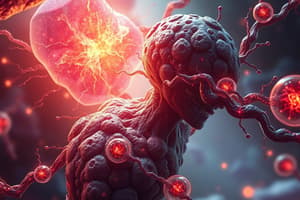Podcast
Questions and Answers
What is the first phase of the cellular respiration process?
What is the first phase of the cellular respiration process?
Glycolysis
What is the second phase of the cellular respiration process?
What is the second phase of the cellular respiration process?
The Krebs Cycle
What is the third phase of the cellular respiration process?
What is the third phase of the cellular respiration process?
Electron Transport Chain
Where in the cell does Glycolysis occur?
Where in the cell does Glycolysis occur?
Where in the cell does the Krebs Cycle occur?
Where in the cell does the Krebs Cycle occur?
Where in the cell does the Electron Transport Chain occur?
Where in the cell does the Electron Transport Chain occur?
How many ATP are made in the glycolysis part of cellular respiration?
How many ATP are made in the glycolysis part of cellular respiration?
How many ATP are made in the Krebs Cycle part of cellular respiration?
How many ATP are made in the Krebs Cycle part of cellular respiration?
How many ATP are made in the electron transport part of cellular respiration?
How many ATP are made in the electron transport part of cellular respiration?
In which phase of cellular respiration is carbon dioxide made?
In which phase of cellular respiration is carbon dioxide made?
In which phase of cellular respiration is water made?
In which phase of cellular respiration is water made?
In which phase of cellular respiration is oxygen a substrate (an input)?
In which phase of cellular respiration is oxygen a substrate (an input)?
In which phase of cellular respiration is glucose a substrate (an input)?
In which phase of cellular respiration is glucose a substrate (an input)?
Only a small part of the energy released from the glucose molecule during glycolysis is stored in ATP. How is the rest of the energy released?
Only a small part of the energy released from the glucose molecule during glycolysis is stored in ATP. How is the rest of the energy released?
What are the 2 metabolic pathways a cell can use and what determines which pathway is used?
What are the 2 metabolic pathways a cell can use and what determines which pathway is used?
Why does glycolysis happen in the cytoplasm?
Why does glycolysis happen in the cytoplasm?
What does the Krebs cycle happen in the mitochondrial matrix?
What does the Krebs cycle happen in the mitochondrial matrix?
Why does the electron transport chain happen in the inner membrane of the matrix?
Why does the electron transport chain happen in the inner membrane of the matrix?
What are NAD+ and FAD? What do they do and what do they become?
What are NAD+ and FAD? What do they do and what do they become?
What are the inputs of glycolysis?
What are the inputs of glycolysis?
What are the outputs of glycolysis?
What are the outputs of glycolysis?
What are the inputs of intermediate?
What are the inputs of intermediate?
What are the outputs of intermediate?
What are the outputs of intermediate?
What is the overall equation for cellular respiration?
What is the overall equation for cellular respiration?
What are the inputs of the Krebs cycle?
What are the inputs of the Krebs cycle?
What are the outputs of the Krebs cycle?
What are the outputs of the Krebs cycle?
What are the inputs of the electron transport chain?
What are the inputs of the electron transport chain?
What are the outputs of the electron transport chain?
What are the outputs of the electron transport chain?
Where does intermediate take place?
Where does intermediate take place?
Flashcards are hidden until you start studying
Study Notes
Cellular Respiration Overview
- Cellular respiration consists of three main phases: Glycolysis, Krebs Cycle, and Electron Transport Chain.
Glycolysis
- Occurs in the cytoplasm of the cell.
- Total of 4 ATP produced; net gain is 2 ATP after accounting for energy investment.
- Involves input of glucose, 2 ATP, and NAD+.
- Outputs include 2 pyruvate, 4 ATP, and 2 NADH.
- Releases some energy as heat.
Krebs Cycle
- Takes place in the mitochondrial matrix.
- Consumes 2 acetyl CoA as input.
- Outputs consist of 6 NADH, 2 FADH2, 2 ATP, and 4 CO2.
- CO2 is produced during this phase.
Electron Transport Chain
- Located in the inner membrane of the mitochondria.
- Inputs include 10 NADH, 2 FADH2, and O2.
- Generates 32-34 ATP and produces water (H2O) as a byproduct.
- Oxygen serves as a substrate in this phase.
Energy Carriers
- NAD+ and FAD are hydrogen and electron carriers.
- They transport H+ and electrons to the Electron Transport Chain, transforming into NADH and FADH2 during Glycolysis and the Krebs Cycle.
Intermediate Stage
- Located within the mitochondrion.
- Begins with 2 pyruvate, resulting in 2 CO2, 2 NADH, and 2 acetyl CoA.
Key Equations
- Overall equation of cellular respiration: C6H12O6 + O2 → CO2 + H2O.
- Aerobic vs. Anaerobic Cellular Respiration is determined by the presence or absence of oxygen.
Enzyme Presence
- Glycolysis occurs in the cytoplasm due to the presence of necessary enzymes.
- The Krebs Cycle is facilitated by enzymes located in the mitochondrial matrix.
- The Electron Transport Chain operates because needed enzymes are found in the inner mitochondrial membrane.
Studying That Suits You
Use AI to generate personalized quizzes and flashcards to suit your learning preferences.




